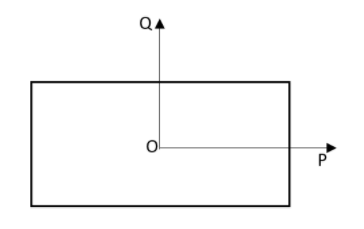
When the magnetic field at P and Q is similar, then what will be the value of OP/OQ?


Answer
557.1k+ views
Hint: The axial magnetic field can be found by taking the ratio of twice the product of magnetic moment and mass of the body to the $4\pi $ time the cube of the distance. The equatorial magnetic field can be found by taking the ratio of the product of magnetic moment and mass of the body to the $4\pi $ time cube of the distance. As the axial magnetic field is equal to the equatorial magnetic field, by comparing both the equations we can find the ratio between the distances. This will help you in answering this question.
Complete step by step answer:
the axial magnetic field can be found by taking the ratio of twice the product of magnetic moment and mass of the body to the $4\pi $ time cube of the distance. This can be written as,
${{B}_{axial}}=\dfrac{2{{\mu }_{0}}m}{4\pi {{d}_{1}}^{3}}$
And the equatorial magnetic field can be found by taking the ratio of the product of magnetic moment and mass of the body to the $4\pi $ time the cube of the distance. That is,
${{B}_{equitorial}}=\dfrac{{{\mu }_{0}}m}{4\pi {{d}_{2}}^{3}}$
As the axial magnetic field is equal to the equatorial magnetic field, we can write that,
${{B}_{equitorial}}={{B}_{axial}}$
We can substitute the values in it,
\[\dfrac{{{\mu }_{0}}m}{4\pi {{d}_{2}}^{3}}=\dfrac{2{{\mu }_{0}}m}{4\pi {{d}_{1}}^{3}}\]
Cancelling the common terms and rearranging the equation can be written as,
\[\begin{align}
& {{\left( \dfrac{{{d}_{1}}}{{{d}_{2}}} \right)}^{3}}=2 \\
& \therefore \dfrac{{{d}_{1}}}{{{d}_{2}}}={{2}^{\dfrac{1}{3}}} \\
\end{align}\]
Therefore the ratio of the distances OP and OQ can be shown as,
\[\dfrac{{{d}_{1}}}{{{d}_{2}}}={{2}^{\dfrac{1}{3}}}\]
Hence the answer has been calculated.
Note: The magnetic moment is defined as the magnetic strength and arrangement of a magnet or other bodies that creates a magnetic field. The common examples for the objects that are having the magnetic moments will be the loops of electric current, moving elementary charges, permanent magnets, different molecules, and many astronomical bodies.
Complete step by step answer:
the axial magnetic field can be found by taking the ratio of twice the product of magnetic moment and mass of the body to the $4\pi $ time cube of the distance. This can be written as,
${{B}_{axial}}=\dfrac{2{{\mu }_{0}}m}{4\pi {{d}_{1}}^{3}}$
And the equatorial magnetic field can be found by taking the ratio of the product of magnetic moment and mass of the body to the $4\pi $ time the cube of the distance. That is,
${{B}_{equitorial}}=\dfrac{{{\mu }_{0}}m}{4\pi {{d}_{2}}^{3}}$
As the axial magnetic field is equal to the equatorial magnetic field, we can write that,
${{B}_{equitorial}}={{B}_{axial}}$
We can substitute the values in it,
\[\dfrac{{{\mu }_{0}}m}{4\pi {{d}_{2}}^{3}}=\dfrac{2{{\mu }_{0}}m}{4\pi {{d}_{1}}^{3}}\]
Cancelling the common terms and rearranging the equation can be written as,
\[\begin{align}
& {{\left( \dfrac{{{d}_{1}}}{{{d}_{2}}} \right)}^{3}}=2 \\
& \therefore \dfrac{{{d}_{1}}}{{{d}_{2}}}={{2}^{\dfrac{1}{3}}} \\
\end{align}\]
Therefore the ratio of the distances OP and OQ can be shown as,
\[\dfrac{{{d}_{1}}}{{{d}_{2}}}={{2}^{\dfrac{1}{3}}}\]
Hence the answer has been calculated.
Note: The magnetic moment is defined as the magnetic strength and arrangement of a magnet or other bodies that creates a magnetic field. The common examples for the objects that are having the magnetic moments will be the loops of electric current, moving elementary charges, permanent magnets, different molecules, and many astronomical bodies.
Recently Updated Pages
Master Class 12 Business Studies: Engaging Questions & Answers for Success

Master Class 12 Social Science: Engaging Questions & Answers for Success

Master Class 12 English: Engaging Questions & Answers for Success

Master Class 12 Chemistry: Engaging Questions & Answers for Success

Class 12 Question and Answer - Your Ultimate Solutions Guide

Master Class 12 Economics: Engaging Questions & Answers for Success

Trending doubts
What are the major means of transport Explain each class 12 social science CBSE

Which are the Top 10 Largest Countries of the World?

Draw a labelled sketch of the human eye class 12 physics CBSE

How much time does it take to bleed after eating p class 12 biology CBSE

Explain sex determination in humans with line diag class 12 biology CBSE

When was the first election held in India a 194748 class 12 sst CBSE




